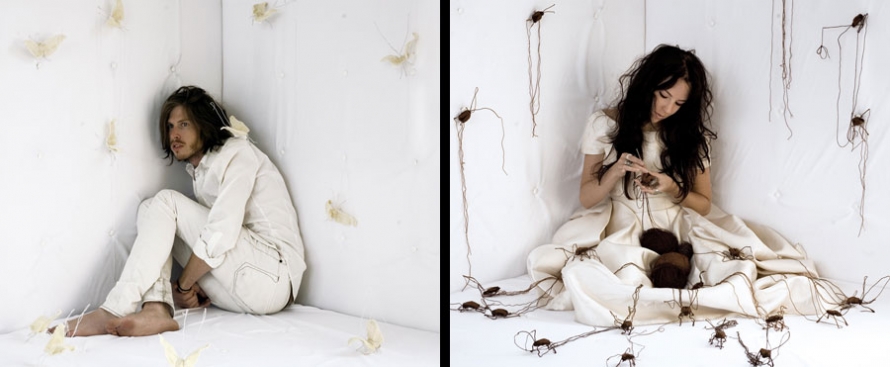Three years ago, Daniela Edburg’s highly stylized photos of women dead from consumption of sweets and snack foods brought humor to classic portraiture and film noir. Now, her most recent show of eerie, dramatic knit materials lends depth, mystery, and nostalgia to the domestic arts. The show is on view at Kunsthaus Santa Fé through March 20, 2010.
Edburg was born in Houston in 1975. Since 2001 her work has been exhibited at The City Museum and Carrillo Gil Art Museum in Mexico City, Guandong Museum of Art in Guangzhou, istituto Europeo Di Design in Mardrid, Itau Cultural of Sao Paulo, Recoleta Cultural Center in Buenos Aires, The National Museum of Visual Arts in Montevideo, The National Museum of Fine Arts in Santiago de Chile, The National Center for Contemporary Arts of Moscow, and The Santa Monica Art Center in Barcelona.
What’s interesting to you about knitting?
I learned to knit when I was a child. My grandma taught me. I learned how to crochet in sixth grade when I was studying with the nuns for a year. It was something I did for a very short while and then a couple years ago when I took it up again I realized the feel of the yarn and the clicking of the needles was very soothing to me. Crocheting is my favorite now, I can go really fast and there is a sense of immediate satisfaction, you advance very quickly, you can improvise, go in any direction, freestyle. It is also a relatively effortless activity, one that can accompany conversations, travel, listening to radio shows, or watching a movie.
Whenever I see a person knitting I can’t help being drawn to them—it’s hypnotic. I silently analyze the texture of the yarn, the choice of colors, I imagine the sweater or the scarf already finished, how it feels to the touch, how it will look when its been worn for years. It makes me nostalgic even, reminds me of the passing of time.
Why did you start knitting compulsively?
For me it began to be a form of occupational therapy, even without knowing what I was doing. I started knitting long strips of fluffy pink material, and after a while I realized it was perfect to put together a brain, and a nice new fluffy brain was exactly what I needed at the moment, a soft and simple version. Knitting and crocheting are basic activities that permit me to build something without worrying about the concept or the story or where I am going, satisfying my need to “do something” and clearing my mind as I do it, slowly it materializes literally into a clear idea. I like this process.
What were some challenges in working with knit materials?
You have to be patient, not really being able to schedule a shoot precisely. My grandmother helped me tremendously and she is a fast knitter, but for instance with the banquet I kept thinking of things I could add—salt and pepper shakers, an ashtray. When it all started looking a bit crowded then I realized it was finally time to schedule the shoot—a year had passed, and the banquet was also getting dirty and full of hair, as it was my cats’ favorite napping place.
How did you get the materials and the shoots together?
When I did the first photo that included knitting, “Party Girl,” I had a grant from the National Fund for Arts and Culture. I had a strict deadline. I put an ad on the radio asking for fast knitters and interviewed several women. I worked with two of them to create the square of grass and flowers—they were so fast and I was so slow, I would have never made my deadline without their help.
I interviewed you about three years ago about your Drop Dead Gorgeous photographs. What have you been up to since then, besides making this work?
After big changes in my life and a lot of moving around, I am finally in a place where I feel at home. This show for me is especially significant because of this. It is the result of a period of vulnerability and restless creativity finally settling down.
When I interviewed you about “Drop Dead Gorgeous,” you explained how “through color, composition, and humor you can create the illusion that something is aesthetically pleasing when, in reality, it could be horrible or gross.” I definitely see that using knitting as a theme makes these potentially gross scenes funnier—what is it about knitting that lightens the whole scene up?
I think in this newer work I’ve actually stopped using humor as a way of communicating. They have also ceased to have a clear story, I think the images are pretty dramatic, but there is a mystery to me as to what some of these characters are going through. There is an ambiguity to what it is that moves them. They are obstinate and endearing, I really feel connected to them.
The characters in your photographs are all alone with these knit objects and they sometimes seem like they’re in danger. Is there something insidious or post-apocalyptic about knitting?
I think this series is pretty introspective. The characters are alone, dealing with themselves in a very intense manner. For me the knitting can represent many things: the creation of a safe place, a form of protection. It also represents creativity in its most basic form and an obsession channeled or harnessed in an attempt to preserve mental health.
Are our obsessions, desires, hobbies killing us?
I would say they are saving us.










